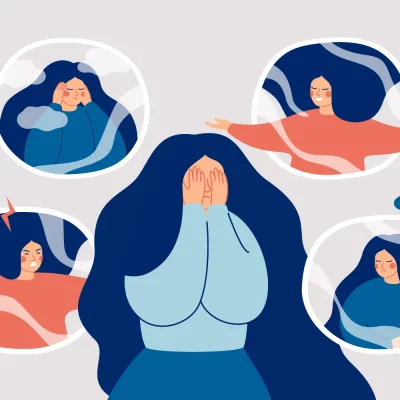Have you ever found yourself in a toxic relationship, unable to leave despite the turmoil and pain it brings you? Do you keep coming back to someone who hurts you, even though you know it’s not good for you? If yes, you might be in a trauma bond.
Trauma bonds are powerful emotional connections that form between people who have experienced significant emotional pain or trauma together. It’s a bond based on shared experiences of trauma, which creates a destructive cycle of attachment and pain.
This blog post will cover everything you need to know about trauma bonds, including how to recognize and the steps to end the cycle.
What Are Trauma Bonds?
Trauma bonds occur when a person emotionally attaches to someone who hurts them repeatedly. The bond is typically formed in relationships with a power imbalance.
The power holder uses their leverage to manipulate and control the other person. At the same time, the victim feeds the relationship with their emotional attachment. This state of dependency is the main distinguishing factor between a trauma bond and other regular intimate bonds.
How Do Trauma Bonds Develop?
Trauma bonds usually form under circumstances of fear, unpredictability, and inconsistency. For instance, an emotionally or physically abusive partner can push a victim into a cycle of abuse and reward.
This cycle of violence makes the victim emotionally invested in the abusive relationship, creating a potentially lifelong struggle to break free.
An example of a trauma bond in a romantic relationship is John and Jane. They have been together for five years. Although their relationship started out strong, it eventually became marred by John’s controlling behavior. Jane found herself constantly second-guessing her decisions and trying to please John to avoid his outbursts of anger.
The combination of physical and emotional abuse left Jane feeling scared
How To Identify A Trauma Bond
When you are in a toxic situation, it’s sometimes hard to see things clearly because you are in the thick of things. Here are 11 common signs that you are in a trauma-bonded relationship:
- Emotional dependency
- Fear of abandonment
- Self-doubt and low self-esteem
- Unhealthy need to please the other person
- Constantly torn between your partner’s positive and negative qualities
- Always giving excuses or feeling responsible for your partner’s behavior
- Difficulty making decisions without approval from the partner
- Feeling as if you owe something to your partner, even if it is an unhealthy situation
- A sense of reward or pleasure when compliments or attention are given by the abuser
- Giving yourself rationalizations for staying in a toxic relationship
- Reluctance to confront problems head-on due to fear or feelings of loyalty
If you identify with many of these signs, chances are you are experiencing toxic behavior from your partner.
The 4 Stages of Trauma Bonding
Trauma-bonded relationships typically repeat 4 stages of behavior routinely within the relationship. This is the cycle of abuse for this type of relationship.
1. The Idealization Stage
In this stage, the bond between the couple is strong and positive. During this stage, the abuser showers their partner love and attention, making them feel appreciated and special.
2. The Devaluation-Withdrawal Stage
In this stage, the abuser begins to distance themselves emotionally and physically. This can lead to feelings of insecurity, confusion, and sadness in the victim.
3. The Disorderly Conduct Stage
In this stage, the abuser’s behavior becomes volatile and unpredictable. This is where physical abuse can take place. This is sadly common: 1 in 3 women and 1 in 4 men have experienced physical violence by an intimate partner.
4. The Reconciliation Stage
In this stage, the abuser apologizes for their behavior and reestablishes a connection with their partner. This creates a strong loyalty in the victim, further reinforcing the trauma bond.
The 7 Steps to End Your Trauma Bond
Breaking free from a trauma bond is not easy, but it’s possible. It takes time and support to heal and create healthy mindsets after experiencing this type of dynamic.
The following are 7 steps to end the cycle of a trauma-bonded relationship:
Step 1: Recognize that your relationship is toxic.
It can be challenging to see how toxic an abusive relationship is while you’re in the thick of it. Taking time to pinpoint how things are unhealthy can give you a wake-up call to how harmful the situation is.
Step 2: Begin to set boundaries and enforce them.
If you’ve been in an abusive situation for a long time, it can feel strange to think having a personal boundary is OK. Take notice of what makes you feel bad, and think about how you can say no or not accept this behavior. If something hurts you, know you don’t deserve to feel that way or have to take that behavior.
Step 3: Understand that you don’t have to explain your decision to anyone but yourself.
It is OK for you to make a decision for yourself that others question or don’t understand. This decision is for no one else except for you. No one needs to validate what you know is best for yourself.
Step 4: Talk to a trusted friend or family member to make them aware of the situation.
Being in an abusive situation feels incredibly isolating, especially if you don’t realize how bad things are. Telling someone else about it can bring up feelings of guilt or shame. It may feel easier to deal with this alone, but reaching out to a loved one can feel free. They can validate your experience and offer support while you try to change things.
Step 5: Focus on healing yourself.
Understand that it is OK to want to focus on yourself and feel better. It can feel awkward or wrong at first to spend time thinking of yourself when you usually spend time thinking about how your partner feels.
Step 6: Consider focusing on self-love and care with the help of a therapist or mental health professional.
In abusive situations, losing any sense of love for yourself is common because you are constantly told you are unlovable. Working with a therapist to regain a sense of self-love and self-care to repair your view of your personal value is important.
Step 7: Work with them through your emotional pain and identify relationship patterns that may attract trauma bonds.
There are real reasons why people end up in this type of relationship. If those root causes or past experiences don’t get processed properly, this cycle of abuse could also happen again in your next relationship.
Conclusion
Trauma bonds are incredibly damaging relationships that no one should ever experience but is far too common. By identifying signs you relate with you can determine if you may be in this relationship dynamic.
Working through the steps to end this type of abuse can take time. Healing is a process, so be patient with yourself while you unlearn coping mechanisms and learn what healthy behavior looks like. Don’t be hard on yourself if it takes a while to detach from the situation.
If you feel like you are in a toxic relationship and need guidance as to how to heal yourself, give us a call or make an appointment. We have therapists who specialize in abuse and trauma and can help you process what you’ve been through so you can live a happier, healthier life.
Your safety is the most important thing. If you or someone you know is experiencing domestic violence and their safety is in jeopardy right now, call 911. You can also call The Domestic Violence Support Hotline
or text START to 88788 to text for support. Visit their website to utilize their chat service there.









This Post Has 2 Comments
This was highly informative. I was able to identify with the signs of trauma bonded individuals. I feel a sense of freedom and hope as a result of taking the first step in admitting I am in a trauma bonded relationship, so thank you.
Thank you for sharing your experience, Sandy. It is easy to fall into day-to-day living and not realize something around you may be unhealthy for you. Understanding the signs, and knowing you identify with them is a monumental step in understanding yourself, how you attach to others, and what you need in order to feel healthy and secure.